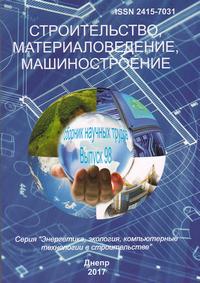The effect of diffusive permeability on the corrosion resistance of polymer concrete
Keywords:
corrosion, polymer concrete, brick, diffusion permeability, crushed stone, corrosive mediumAbstract
Annotation. Purpose. Investigation of the diffusion permeability effect on the corrosion resistance of polymer concrete. Methodology. As a material we've chosen furan polymer concrete based on the monomer FA and FAM. In our studies, we determined the kinetics and values of the diffusion penetration of a sulphuric acid solution (in the range of 5-30%) and water into cured unfilled binders, polymer mastics and polymer concrete. The diffusion coefficient was determined on sample disks for unfilled binders and polymer mastics d = 50 mm, thickness 3-5 mm; for polymer concrete d = 150 mm, thickness 20-40 mm. Before putting the samples into aggressive media, they were weighed accurate to within 0.01 g. After 3,7,14,21 days, 1,3,6,9,12 months, samples were taken out of corrosive media, washed with distilled water, drained with a filter paper and weighed. Weighing was carried out until the samples reached a constant mass value. Results. With increasing aggressive media concentration the time of its penetration into the polymer concrete increases. Water in terms of diffusion is more active liquid in comparison with acid solutions. The permeability of polymer-tones on rubble from the battle of acid-resistant brick is less than that of polymer concrete on granite crushed stone. The diffusion coefficient of polymer concrete is higher than the diffusion coefficient of polymer mastics, and the diffusion coefficient of samples on modified furan resins is lower than on the monomer FA. Scientific novelty and practical significance. The combination of FA and FAM monomers with cheaper and more accessible polymers is one of the ways to expand the raw material base for the binders production and reduce the cost of polymer concrete. In this case the combination of furan resins with the waste of by-product coking - acidic tar (waste products from the distilleries of crude benzene) is promising.References
Ershov V.M., Zarigov A.A., Hodin V.G. i dr. Himicheskaja stojkost' i polzuchest' polimernyh furanovyh svjazuju-shhih. [Chemical stability and creep of polymer furane connective] – Nauchnye trudy Saratovskogo politermicheskogo instituta, 1984. – Vyp. 70. – S.91-95.
Irtuganova S.K., Mamotov Ju.M., Diuman V.S. i dr. Polimerrastvory na osnove furfurolacetonovoj smoly razlichnyh modifikacij [Polimersolutions on substrate furfuralcohol resin of various modifications]// Beton i zhelezobeton. - 1994. – №8. – S.19-20.
El'shin I.I. Plastbeton. [Plastbeton] - Kiev: Budіvel'nik, 1997. – 125 s.
Baress R. Einige Physikalische Eigenschegten der kumdidstoff-Betone. – «Zement-kalk-Gips», 1991, №4.
Sumy R. N. Anwendungsbazeiche fur Fasez und Polymerbeton. - «Baustoffindustrie», 1996, BL 19, №38. – S.30-32.
Radoliff A.T. Furane reisens. «Develop thermoset, Plast», London, 2007. 7. Knab L.J., Cook I.P. Shear and flexural Behavior of reinforced polyesters concrete beans, - «Journal of the American Concrete Institute», 2003, №10. – S. 493-501.
Ivanov A.M., Algazinov H.Ja., Martynec D.V. Stroitel'nye konstrukcii iz polimernyh materialov. [Building structures from polymeric materials Textbook for high schools] Uchebnoe po-sobie dlja vuzov. – M.: Vysshaja shkola, 2003. – 239 s.
Himija adgezii (perevod s japonskoj stat'i Imato T. Poverhnost' tela, adsorbcija i adgezija, kinetika processov ad-gezii). [Chemistry of adhesion] – M.: Bjuro perevodov, 2001. – 33 s.
Huvink R., Staverman A. Himija i tehnologija polimerov. [Chemistry and technology of polymers] – Iz-vo Himija. – M.S.P.: 2004.
Downloads
Published
Issue
Section
License
Редакція Видання категорично засуджує прояви плагіату в статтях та вживає всіх можливих заходів для його недопущення. Плагіат розглядається як форма порушення авторських прав і наукової етики.
При виявлені у статті більш ніж 25% запозиченого тексту без відповідних посилань та використання лапок, стаття кваліфікується як така, що містить плагіат. У цьому випадку стаття більше не розглядається редакцією, а автор отримує перше попередження.
Автори, в статтях яких повторно виявлено плагіат, не зможуть публікуватися в усіх журналах Видавництва ДВНЗ «Придніпровська державна академія будівництва та архітектури».
Автори, які публікуються у цьому журналі, погоджуються з наступними умовами:
- Автори залишають за собою право на авторство своєї роботи та передають журналу право першої публікації цієї роботи на умовах ліцензії Creative Commons Attribution License, котра дозволяє іншим особам вільно розповсюджувати опубліковану роботу з обов'язковим посиланням на авторів оригінальної роботи та першу публікацію роботи у цьому журналі.
- Автори мають право укладати самостійні додаткові угоди щодо неексклюзивного розповсюдження роботи у тому вигляді, в якому вона була опублікована цим журналом (наприклад, розміщувати роботу в електронному сховищі установи або публікувати у складі монографії), за умови збереження посилання на першу публікацію роботи у цьому журналі.
- Політика журналу дозволяє і заохочує розміщення авторами в мережі Інтернет (наприклад, у сховищах установ або на особистих веб-сайтах) рукопису роботи, як до подання цього рукопису до редакції, так і під час його редакційного опрацювання, оскільки це сприяє виникненню продуктивної наукової дискусії та позитивно позначається на оперативності та динаміці цитування опублікованої роботи (див. The Effect of Open Access).

